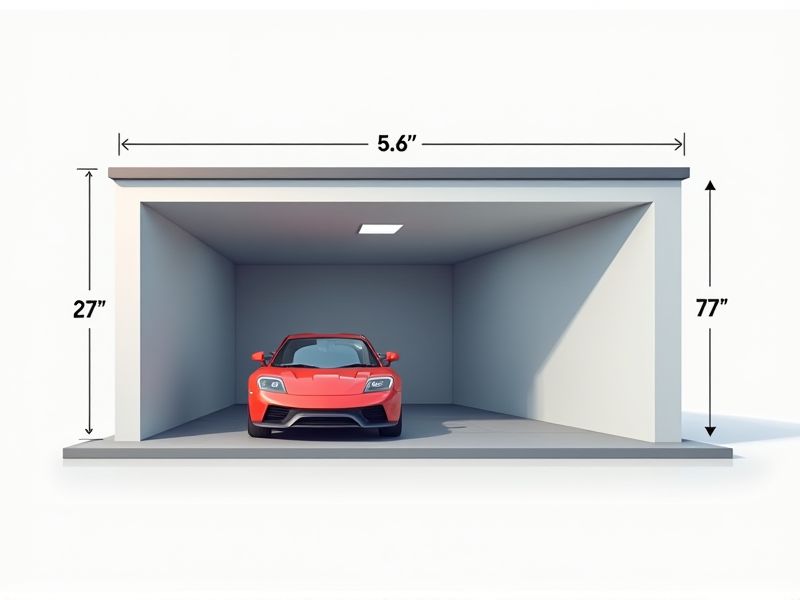
When planning a car garage, knowing the standard dimensions ensures your space will comfortably fit your vehicle and allow for easy entry and exit. Typically, a single-car garage measures about 12 feet wide by 20 to 24 feet deep, which accommodates most cars and provides a little extra storage. For a two-car garage, a common size is 20 to 24 feet wide by 20 to 24 feet deep, offering sufficient room for two vehicles side by side. Before finalizing your plans, consider your car's size and any additional needs, such as workspace or storage, to ensure the garage meets your requirements.
Width
The standard width for a single car garage typically measures 12 to 16 feet, providing sufficient space for your vehicle and access to storage. For a double car garage, the recommended width is between 18 to 24 feet, allowing comfortable maneuvering for two cars. Furthermore, consider adding extra width if you plan to store tools or equipment alongside your vehicles. Ensuring the garage is at least 7 feet high will accommodate most vehicles, enhancing the overall utility of your garage space.
Length
The standard length for a single-car garage typically ranges from 20 to 24 feet, accommodating most vehicles comfortably while allowing for additional storage options. For a double-car garage, the length often extends to 22 to 26 feet, providing sufficient space for two vehicles and room for movement. When planning your garage, consider the overall depth, which usually measures between 12 to 14 feet, to ensure adequate space for workshops or storage solutions. These dimensions not only optimize functionality but also enhance the overall usability of your garage space.
Height
A standard car garage typically requires a minimum interior height of 8 feet (2.44 meters) to accommodate most vehicles comfortably. Taller SUVs and trucks may necessitate a height of 10 feet (3.05 meters) or more, allowing for sufficient clearance when entering and exiting. When planning your garage, consider adding an extra foot for overhead storage or future modifications. This height ensures not only functionality but also ease of use for larger vehicles, tools, and storage solutions.
Door Size
A standard car garage typically requires a door width of at least 16 feet and a height of 7 to 8 feet, accommodating most vehicles comfortably. For a single-car garage, dimensions may shrink to around 9 to 10 feet in width and 7 to 8 feet in height. Consider opting for insulated doors, which can enhance energy efficiency and prevent temperature fluctuations inside your garage. When planning your garage layout, ensure there's enough clearance around the door for easy access and maneuverability.
Clearance Space
The standard clearance space in a car garage is typically a minimum of 7 to 8 feet in height to accommodate standard vehicles, while the width should allow for at least 12 to 16 feet of maneuvering room. This configuration ensures you can open car doors fully without risking damage to adjacent walls or vehicles. An accessible garage layout not only enhances functionality but also improves safety, significantly reducing the likelihood of accidents when parking or entering and exiting the car. Proper clearance can also facilitate the addition of storage solutions, allowing you to optimize your garage space effectively.
Ventilation
Proper ventilation in a car garage is crucial for maintaining air quality and preventing the buildup of harmful fumes. A recommended air exchange rate is about 6 to 12 times per hour, ensuring fresh air circulation. Installing ventilation systems, such as exhaust fans or windows that can be opened, can effectively reduce humidity and eliminate potentially hazardous gases like carbon monoxide. Your garage should ideally maintain a temperature range of 50degF to 85degF to provide a comfortable working environment while safeguarding your vehicle and tools.
Lighting
Proper lighting in a car garage enhances visibility and safety, making it essential for any vehicle owner. Aim for a minimum of 300 to 500 lumens per square meter to ensure optimal illumination, significantly reducing shadows that could obstruct your view. Investing in LED lights not only improves energy efficiency, offering a lifespan of up to 50,000 hours, but also requires minimal maintenance. Consider motion-sensor lights for convenience and security, automatically activating when you enter the space, ensuring your garage is always well-lit when you need it.
Storage Space
A standard car garage typically measures around 20 by 20 feet, providing a spacious area for a vehicle while accommodating essential storage solutions. With proper organization, you can optimize vertical space by installing shelves or cabinets, allowing for the storage of tools, seasonal items, and outdoor equipment. Utilizing wall-mounted racks can further enhance your garage's functionality, ensuring that you maximize available square footage and keep the floor area clear. Investing in storage bins and clear containers allows you to easily access your belongings while maintaining a tidy and efficient environment.
Flooring Material
A high-quality car garage floor typically features durable materials like epoxy, polyurethane, or polyaspartic coatings, which provide resistance to chemicals and abrasions. Epoxy floors can last up to 15 years or more with proper maintenance, while polished concrete offers a sleek finish and can endure heavy loads. For those seeking slip resistance, textured vinyl tiles or rubber flooring options are ideal choices, ensuring safety during wet conditions. Your investment in flooring not only enhances durability but also promotes cleanliness and reduces maintenance costs over time.
Driveway Access
The standard driveway access for a car garage typically measures a minimum width of 10 to 12 feet, ensuring smooth entry and exit for vehicles. Adequate space is crucial, with at least 20 feet of depth recommended to allow for maneuvering without obstruction. Local zoning regulations may also dictate specific requirements based on your home's location, making it essential to check municipal codes. A well-designed driveway not only enhances functionality but also contributes to the overall aesthetic and value of your property.
